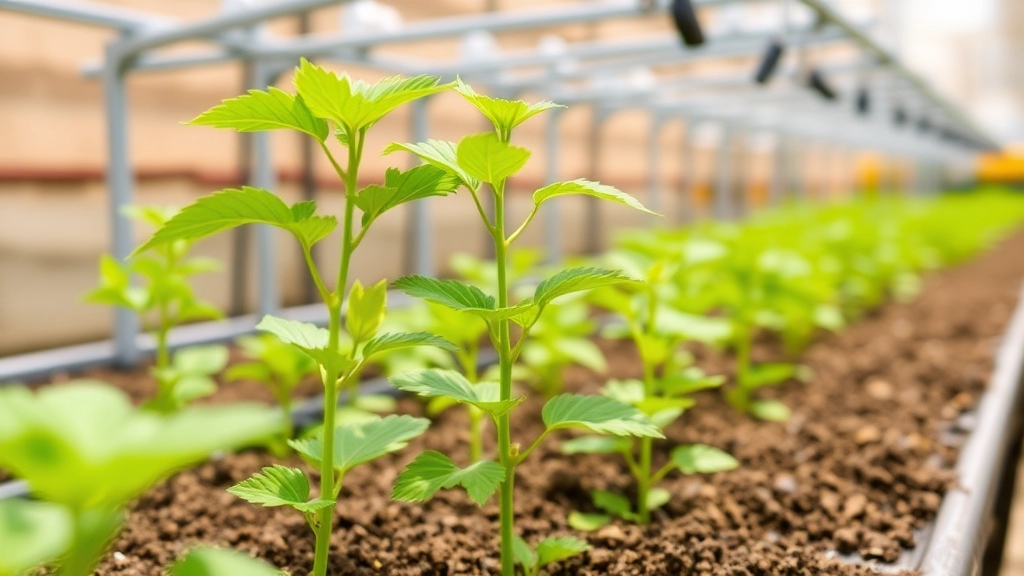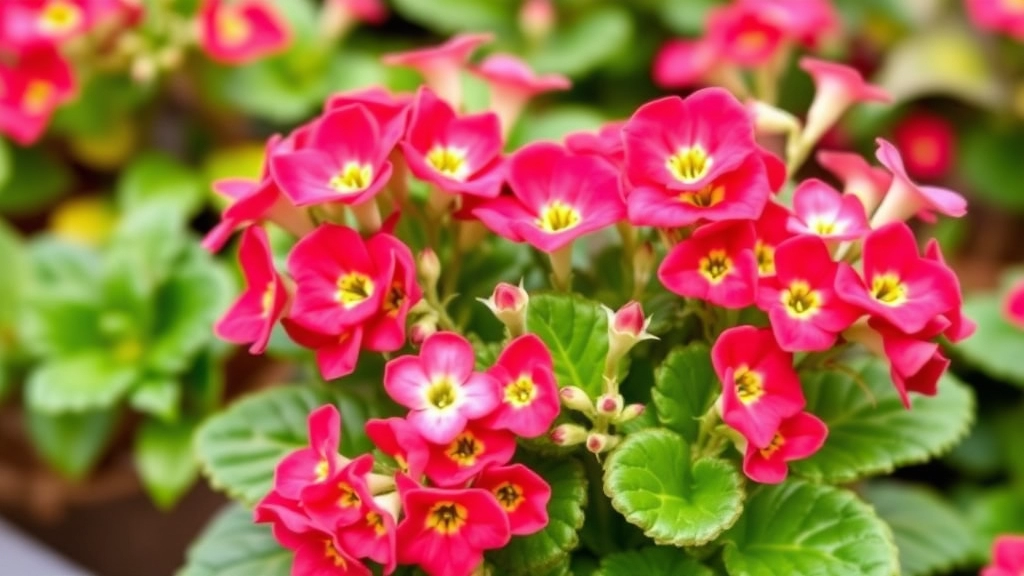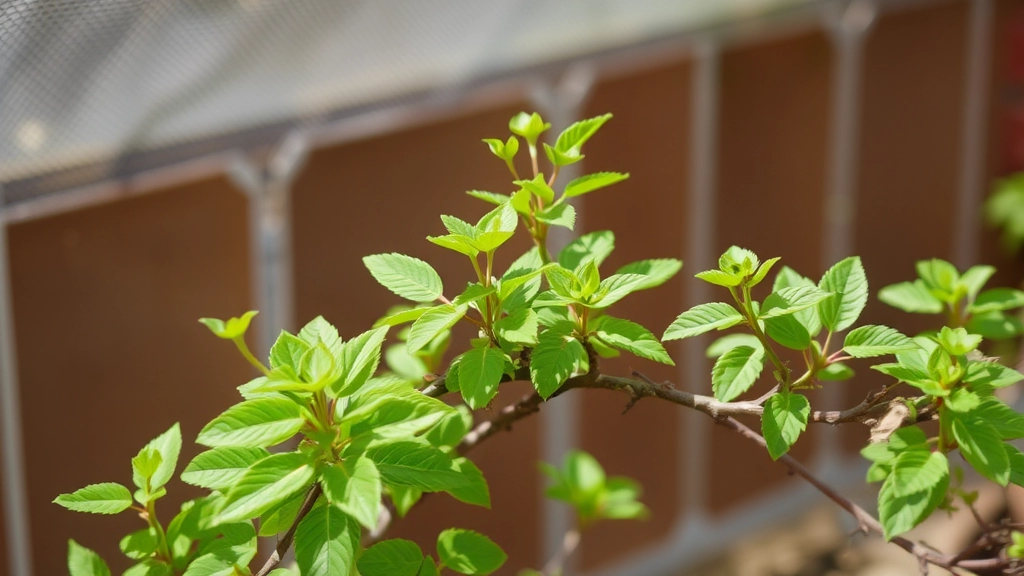Growing Kalanchoe in Florida
Growing Kalanchoe in Florida can be a rewarding experience if you know the right steps. I’ve found that these vibrant succulents thrive in the Sunshine State’s climate, but there are a few key things to keep in mind.
Key Steps for Growing Kalanchoe
- Soil: Make sure to plant them in well-draining soil to avoid root rot.
- Sunlight: Place them where they can get plenty of sunlight, as they love basking in the rays.
Watering Tips
Watering is crucial; overwatering can be a death sentence for Kalanchoe. I recommend watering them only when the soil feels dry to the touch.
Pest Management
Additionally, keep an eye out for pests like aphids and mealybugs, which can be a nuisance.
With these simple tips, you’ll have no trouble growing Kalanchoe in Florida and enjoying their beautiful blooms year-round.
Best Kalanchoe Varieties for Florida
When considering Kalanchoe for your Florida garden, you might wonder which varieties thrive best in the state’s unique climate.
Kalanchoe, known for its vibrant blooms and hardy nature, offers several varieties that flourish in Florida’s warm and humid conditions.
Popular Kalanchoe Varieties
- Kalanchoe Blossfeldiana
- This variety is a favourite for its colourful clusters of flowers, blooming in shades of red, pink, yellow, and white.
- It’s perfect for containers or as a bedding plant.
- Kalanchoe Tomentosa (Panda Plant)
- Featuring fuzzy, grey-green leaves, this succulent adds a unique texture to your garden.
- Its striking appearance makes it a great conversation starter.
- Kalanchoe Luciae (Flapjack Plant)
- Known for its large, flat leaves that turn a beautiful red in full sun.
- This variety is drought-tolerant and easy to care for. For more information, check out our ultimate guide for healthy growth.
- Kalanchoe Fedtschenkoi (Chandelier Plant)
- With its cascading stems and unique leaf shape, it’s perfect for hanging baskets.
- It produces small, tubular flowers that attract pollinators.
- Kalanchoe Pinnata (Mother of Thousands)
- This variety is known for its ability to produce plantlets along its leaf edges.
- It’s an excellent choice for those looking to propagate easily. Learn more about how to propagate Kalanchoe Mother of Thousands.
Ideal Growing Conditions

So, you’ve got your Kalanchoe and you’re excited to see it thrive in Florida’s sunny climate. But what’s the secret sauce for getting it to really flourish?
Sunlight
Kalanchoes love the sun, but they’re not fans of the scorching heat all day long.
- Location: Aim for a spot that gets bright, indirect sunlight.
- Duration: About 6 hours of sunlight is perfect.
Too much direct sun can scorch their leaves, while too little can stunt their growth.
Temperature
Florida’s weather is generally a friend to Kalanchoes, but they still have their preferences.
- Ideal Range: They thrive in temperatures between 60°F to 85°F (15°C to 29°C).
- Cold Sensitivity: Anything below 50°F (10°C) can stress them out.
If a cold snap hits, consider bringing them inside.
Humidity
Kalanchoes aren’t too picky about humidity, but they do appreciate a balanced environment.
- Optimal Level: They do well in average household humidity.
- Avoid Excess: Too much moisture can lead to rot.
If your home is particularly humid, ensure good airflow around your plants.
Soil
The right soil can make all the difference.
- Well-Draining Mix: Use a cactus or succulent mix.
- DIY Option: Mix regular potting soil with sand or perlite for better drainage.
This helps prevent root rot, which is a common issue for Kalanchoes.
## Planting and Soil Preparation
When you’re ready to plant your Kalanchoe, understanding the right soil and preparation techniques is crucial for ensuring healthy growth.
### Soil Type
Kalanchoe thrives in well-draining soil. Here are some key points to consider:
– **Cactus Mix**: A commercial cactus mix is ideal due to its excellent drainage properties.
– **DIY Mix**: If you prefer to make your own, combine equal parts of potting soil, perlite, and sand. This blend promotes aeration and prevents water retention.
### Site Selection
Choosing the right location can make all the difference. Kalanchoe loves bright, indirect sunlight. Here’s how to find the perfect spot:
– **Indoor Placement**: A south or west-facing window is ideal.
– **Outdoor Settings**: If planting outside, select a spot that receives partial shade, especially during the hottest part of the day.
### Planting Steps
Once you’ve chosen your soil and site, follow these simple steps:
1. **Prepare the Pot**: Ensure your pot has drainage holes to prevent waterlogging.
2. **Fill with Soil**: Add your chosen soil mix, filling the pot about two-thirds full.
3. **Position the Plant**: Remove the Kalanchoe from its nursery pot and gently loosen the roots. Place it in the centre and fill around it with soil.
4. **Water Lightly**: After planting, give it a light watering to settle the soil. Avoid soaking the roots.
### Final Touches
– **Mulch**: A thin layer of gravel or small stones on top can help retain moisture while ensuring good air circulation.
– **Check Drainage**: After watering, observe how quickly the excess drains. Adjust your soil mix if necessary.
For more detailed guidance on **[essential Kalanchoe care tips for summer success](https://planthq.org/essential-kalanchoe-care-tips-for-summer-success/)** and **[how to deadhead Kalanchoe flowers for continuous blooming](https://planthq.org/how-to-deadhead-kalanchoe-flowers-for-continuous-blooming/)**, visit our comprehensive guides.
Watering and Fertilizing Tips for Kalanchoe

When it comes to caring for your Kalanchoe, understanding how much water and nutrients to provide is crucial. Many plant enthusiasts often worry about overwatering or under-fertilising their beloved succulents.
Watering Guidelines
- Frequency: Water your Kalanchoe every 2-3 weeks during the growing season (spring and summer). In the dormant months (autumn and winter), reduce watering to once a month.
- Method: Ensure you water thoroughly, allowing excess to drain out of the pot. This prevents root rot, a common issue with Kalanchoe.
- Soil Check: Always check the top inch of soil. If it feels dry, it’s time to water. If it’s still moist, wait a few more days.
- Signs of Stress: Yellowing leaves can indicate overwatering, while shrivelling leaves suggest underwatering. Adjust your routine accordingly.
Fertilizing Essentials
- Type of Fertilizer: Use a balanced, water-soluble fertiliser diluted to half strength. A succulent-specific fertiliser can also work wonders.
- Frequency: Fertilise every 4-6 weeks during the growing season. Avoid fertilising in the dormant months.
- Application: Apply fertiliser after watering to prevent root burn. This ensures your Kalanchoe absorbs nutrients effectively.
- Signs of Nutrient Deficiency: If your plant’s growth slows or leaves turn pale, it may need more nutrients.
As you nurture your Kalanchoe, it’s essential to stay vigilant about potential pests and diseases that could threaten your plants.
### Common Pests to Watch For:
– **Aphids:** Tiny green or black insects that suck sap from the leaves.
– **Mealybugs:** Cotton-like pests that cluster in leaf axils and on stems.
– **Spider Mites:** Microscopic pests that create fine webs and cause leaf discoloration.
### Signs of Infestation:
– Yellowing leaves
– Wilting or drooping
– Sticky residue on leaves (honeydew)
### Effective Management Strategies:
1. **Regular Inspections:** Check your plants weekly for any signs of pests.
2. **Natural Predators:** Introduce ladybugs or lacewings to keep aphids in check.
3. **Insecticidal Soap:** Use a diluted solution to spray directly on affected areas.
4. **Neem Oil:** A natural pesticide that can deter various pests without harming your plants.
### Preventing Diseases:
Kalanchoes can also fall victim to diseases, primarily due to overwatering or poor air circulation.
### Common Diseases:
– **Root Rot:** Caused by overly wet soil, leading to mushy roots.
– **Powdery Mildew:** A fungal disease that appears as a white powder on leaves.
### Prevention Tips:
1. **Well-Draining Soil:** Ensure your potting mix allows excess water to escape. For more information on soil, check out the [best soil for Kalanchoe Blossfeldiana care tips](https://planthq.org/best-soil-for-kalanchoe-blossfeldiana-care-tips/).
2. **Adequate Spacing:** Position your plants to promote airflow.
3. **Watering Practices:** Water at the base of the plant, avoiding leaf wetness. For detailed watering tips, refer to [optimal watering tips for healthy Florist Kalanchoe](https://planthq.org/optimal-watering-tips-for-healthy-florist-kalanchoe/).
VI. Pruning and Propagation

So, you’re looking to keep your Kalanchoe thriving? Pruning and propagation are key parts of the journey.
Why Prune Your Kalanchoe?
Pruning isn’t just about aesthetics; it’s essential for the plant’s health.
- Encourages Growth: Snipping off dead or wilted leaves helps the plant focus its energy on new growth.
- Promotes Blooms: Regular pruning can lead to more vibrant flowers.
- Controls Size: If your Kalanchoe is getting a bit too bushy, a little trim can keep it in check.
How to Prune
Here’s a simple step-by-step:
- Gather Tools: You’ll need clean, sharp scissors or pruning shears.
- Identify What to Cut: Look for dead leaves, spent flowers, or any leggy growth.
- Make Clean Cuts: Cut just above a leaf node to encourage new growth.
- Dispose of Debris: Collect the trimmings to prevent pests and diseases.
Propagation Made Easy
Now, if you’re keen to expand your Kalanchoe collection, propagation is a fun way to do it.
- Leaf Cuttings:
- Snip a healthy leaf.
- Let it dry for a day to form a callus.
- Place it in well-draining soil and keep it moist but not soggy.
- Stem Cuttings:
- Cut a healthy stem just below a node.
- Allow it to dry for a few hours.
- Plant it in soil, keeping it warm and bright.
Tips for Success
- Timing: The best time to prune and propagate is during the growing season, typically spring and summer.
- Patience: New plants can take a few weeks to root, so hang tight!
Seasonal Care and Maintenance
As we transition through the seasons, understanding how to care for your Kalanchoe can make all the difference in its health and vibrancy.
FAQs on Growing Kalanchoe in Florida
What are the ideal sunlight conditions for Kalanchoe in Florida?
Kalanchoes thrive in bright, indirect sunlight. They need about 6 hours of sunlight daily. Too much direct sun can scorch their leaves, while too little can stunt their growth.
What temperature range is best for Kalanchoe?
Kalanchoes prefer temperatures between 60°F to 85°F (15°C to 29°C). They are sensitive to cold and can be stressed by temperatures below 50°F (10°C).
How should I manage humidity levels for my Kalanchoe?
Kalanchoes do well in average household humidity. Ensure good airflow around your plants to avoid excess moisture, which can lead to rot.
What type of soil is best for Kalanchoe?
A well-draining mix is essential. Use a cactus or succulent mix, or mix regular potting soil with sand or perlite to improve drainage.
How often should I water my Kalanchoe?
During the growing season (spring and summer), water every 2-3 weeks. In the dormant months (autumn and winter), reduce watering to once a month. Always check the top inch of soil; if it feels dry, it’s time to water.
What type of fertilizer should I use for Kalanchoe?
Use a balanced, water-soluble fertilizer diluted to half strength. A succulent-specific fertilizer is also effective. Fertilize every 4-6 weeks during the growing season and avoid fertilizing in the dormant months.
Why is pruning important for Kalanchoe?
Pruning encourages new growth, promotes more vibrant flowers, and helps control the size of the plant. It also helps the plant focus its energy on healthy growth by removing dead or wilted leaves.
How do I prune my Kalanchoe?
Use clean, sharp scissors or pruning shears to snip off dead leaves, spent flowers, or leggy growth. Make clean cuts just above a leaf node to encourage new growth. Dispose of the trimmings to prevent pests and diseases.
How can I propagate my Kalanchoe?
Propagation can be done through leaf or stem cuttings. For leaf cuttings, snip a healthy leaf, let it dry for a day, and place it in well-draining soil. For stem cuttings, cut a healthy stem just below a node, let it dry for a few hours, and plant it in soil.
When is the best time to prune and propagate Kalanchoe?
The best time to prune and propagate is during the growing season, typically in spring and summer. Be patient, as new plants can take a few weeks to root.
References
-
Kalanchoe Plant Care: How To Grow A Kalanchoe
-
How to Grow and Care for Kalanchoe
-
Kalanchoe: How to Grow and Care for Kalanchoe Plants
